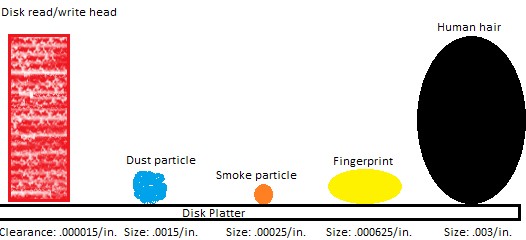
We take care of
all of your IT needs.
all of your IT needs.
Why Did My Hard Drive Fail?
Why Did My Hard Drive Fail?
Some hard disk drives simply fail because of worn out parts, others fail prematurely. In other words the disk platter (see Illustration) has craters or damage to it. This happens with normal wear and tear. It can be sped up by slamming the lid down on laptops or a tower getting hit by a vacuum cleaner or a foot. Please note the very small space between the read/write head and the disk platter.
Drive manufacturers typically specify a mean time between failures (MTBF) or an annualized failure rate (AFR) which are population statistics that cannot predict the behavior of an individual unit. These are calculated by constantly running samples of the drive for a short amount of time, analyzing the resultant wear and tear upon the physical components of the drive, and extrapolating to provide a reasonable estimate of its lifespan. Hard disk drive failures tend to follow the concept of the bathtub curve.[3] Drives typically fail within a short time if there is a defect present from manufacturing. If a drive proves reliable for a period of a few months after installation, the drive has a significantly greater chance of remaining reliable. Therefore, even if a drive is subjected to several years of heavy daily use, it may not show any notable signs of wear unless closely inspected. On the other hand, a drive can fail at any time in many different situations.

From Wikipedia, the free encyclopedia
What to take away from this?
What to take away from this?
You should
always backup your drive! It is not very expensive and somewhat easy to do. If you drive is 5 years or older, you should prepare to replace it. With that said, I have seen drives last over 10 years and fail within a year. Both of those scenarios are rare.
RAID (Redundant Array of Independent Disks)
In computer storage, the standard RAID levels comprise a basic set of RAID configurations that employ the techniques of striping, mirroring, or parity to create large reliable data stores from multiple general-purpose computer hard disk drives (HDDs). The most common types are RAID 0 (striping), RAID 1 and its variants (mirroring), RAID 5 (distributed parity), and RAID 6 (dual parity). RAID levels and their associated data formats are standardized by the Storage Networking Industry Association (SNIA) in the Common RAID Disk Drive Format (DDF) standard. While most RAID levels can provide good protection against and recovery from hardware defects or defective sectors/read errors (hard errors), they don't provide any protection against data loss due to catastrophic failures (fire, water) or soft errors such as user error, software malfunction, malware infection. For valuable data, RAID is only one building block of a larger data loss prevention and recovery scheme - it cannot replace a backup plan.